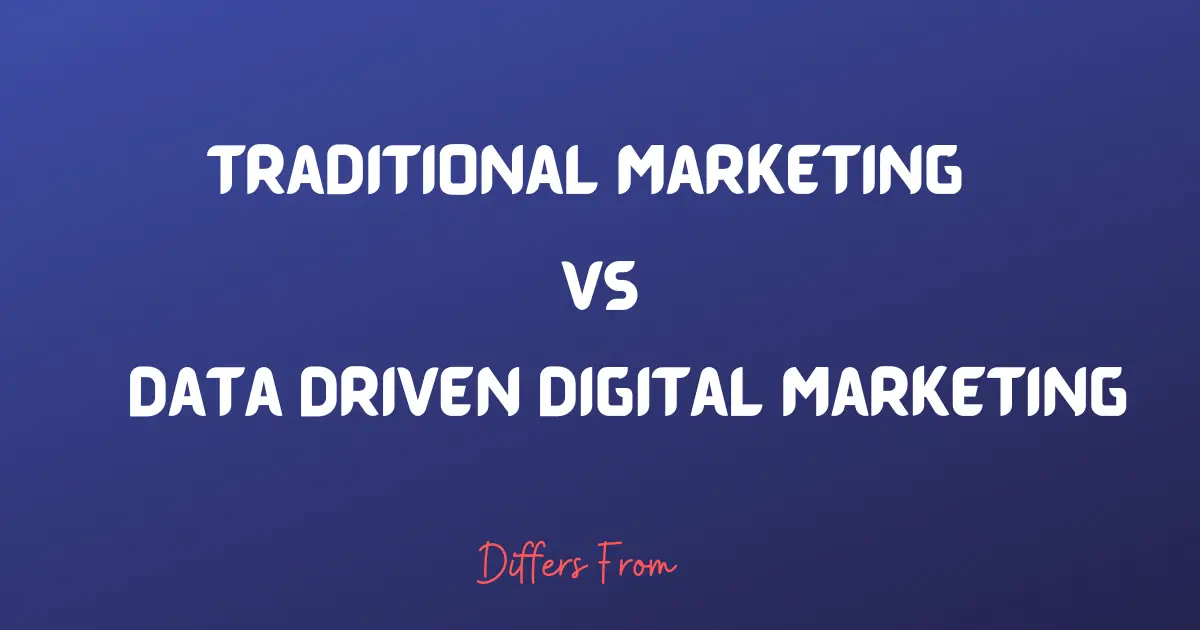As a small bakery specializing in cakes and pastries, you have usually relied on ads in local newspapers, flyers, and word-of-mouth recommendations to bring customers through your door. But as digital marketing has become more popular, you now have access to data and analytics that can help you target your audience better. Google Analytics can tell you which kinds of cakes and pastries are the most popular. And with Facebook Ads, you can make campaigns very specific to age, interests, and location. In this blog article, we will discuss traditional marketing vs. data driven digital marketing in detail.
Digital marketing based on data gives businesses like yours a great chance to reach the right people with the right message and keep costs low. If you use this robust set of tools, you can expect your sales and profits to increase.
Digital marketing based on data is changing the marketing industry and making it easier for businesses to reach the right people. Companies can now use powerful tools like Google Analytics and Facebook Ads to use data to learn about customers’ interests, ages, locations, and more. This lets them make their campaigns as successful and profitable as possible.
No longer can marketing be done based on gut feelings and experience. Digital marketing has replaced traditional marketing based on data, allowing for precise targeting and measuring in real-time.
Traditional Marketing vs Data Driven Digital Marketing
| Characteristic | Traditional Marketing | Data-Driven Digital Marketing |
| Emphasis | Intuition and personal experience | Data and analytics |
| Targeting | Broad targeting strategies | Precision targeting through audience segmentation |
| Channels | Mass media (television, radio, print) | Digital channels and platforms (websites, social media, email) |
| Measurement | Lack of measurable results | Ability to measure outcomes in real-time |
| Approach | Established approach with a proven track record | Relatively new but rapidly growing and evolving |
| Reach | Ability to reach a broad audience | Ability to precisely target the right audience |
| Cost | It can be less expensive than digital marketing. | It can be more expensive but typically offers a better return on investment. |
| Optimization | Limited ability to continuously improve | Ability to constantly optimize and improve through data analysis |
What makes traditional marketing different?
Emphasis on intuition and personal experience
Traditional marketing relies heavily on the instincts and personal experiences of the marketers. For example, if a marketer likes a specific ad message, they might use it without researching or gathering data to support their decision.
Targeting strategies with a wide range of people
Traditional marketing often uses targeting strategies to reach as many people as possible. For example, a car dealership might advertise in a local newspaper to get as many people as possible to buy cars, no matter their needs or interests.
Reliance to mass media
Traditional marketing relies heavily on mass media to reach its target audience. This includes conventional ways like newspaper and magazine ads, radio and TV commercials, and direct mail. For instance, a big clothing store might run a commercial during the Super Bowl to reach many people at once.
No way to measure results
One of the biggest problems with traditional marketing is that you need to measure how well it works. It can take time to figure out how a conventional marketing campaign works and how successful it was. For example, it might be hard to figure out how many people saw a print ad in a newspaper and whether or not it influenced their buying decisions.
Traditional marketing relies a lot on personal experience and gut feelings. It also uses broad targeting strategies and uses mass media a lot. But it needs to measure its effects and how well they work accurately.
Advantages of Traditional Marketing
A method that has been used before and worked
Traditional marketing has been used for a long time and has been shown to work. For decades, companies have used print ads in newspapers and magazines to reach a large audience and boost sales.
The ability to reach many people
Traditional marketing allows you to reach many people. This is especially true for mass media like TV and radio, which can reach many people simultaneously. For example, a company could run a TV ad during a popular prime-time show, reaching millions of people simultaneously.
It can be cheaper than digital marketing.
One of the best things about traditional marketing is that it can be cheaper than digital marketing. For instance, putting an ad in a local newspaper may be more affordable than running a targeted digital campaign on social media.
Traditional marketing has several benefits, such as a tried-and-true method, the ability to reach many people, and possibly lower costs than digital marketing.
What data-driven digital marketing looks like?
The importance of data and analysis
Data and analytics are given much weight in data-driven digital marketing. Marketers use data to make decisions, keep track of their progress, and improve their strategies over time. For example, an online store might use information about what customers buy and how many people visit the site to determine which products sell well and which don’t.
Accurate targeting by dividing the audience into groups
Data-driven digital marketing lets marketers segment their audience into smaller groups based on specific characteristics like age, location, interests, and behavior. This helps them reach their audience more precisely. For example, a travel company might use data to divide its customers into groups based on where they like to travel, how much they can spend on travel, and where they have traveled in the past.
Using digital platforms and channels
Digital marketing based on data reaches its target audience mainly through digital channels and platforms. These include social media platforms, email marketing, search engine marketing, and online advertising. For example, a fitness company could use Instagram and Facebook to reach its target audience and promote its products and services.
Measuring results in real-time
One of the best things about data-driven digital marketing is that it lets you measure results in real time. Marketers can track their progress and change plans using tools like Google Analytics and social media analytics. For example, a store that sells clothes might use real-time data to find out which kinds of clothes are selling well and which ones aren’t and then change their marketing campaigns to reflect that.
Data-driven digital marketing focuses on data and analytics, allows precise targeting through audience segmentation, mainly uses digital channels and platforms, and lets marketers measure their results in real-time.
Advantages of Data-Driven Digital Marketing
The ability to precisely target the right audience
Audience segmentation makes it possible for data-driven digital marketing to target the right audience. For example, a local coffee shop could use data to reach coffee lovers within a 5-mile radius instead of a broader audience that might not be interested in coffee. This precise targeting leads to a better return on investment and a higher conversion rate.
Results that can be measured in real-time
Data-driven digital marketing lets marketers measure results in real-time, so they can see how their campaigns are doing immediately. For example, an online store could use real-time data to track how well a new product is selling and change its marketing efforts to increase sales.
Better return on investment
Digital marketing driven by data often gives a better return than traditional marketing. This is because marketers can use data to ensure that their campaigns are working as well and as efficiently as possible. For example, a financial services company could use data to determine the best ways to reach its target audience through digital channels, leading to a higher return on investment.
The ability to constantly improve and optimize campaigns
Data-driven digital marketing lets marketers improve and optimize their campaigns. They can make intelligent decisions and keep enhancing their strategies by keeping track of their progress and measuring their results with data. For example, a fitness company could look at the data to find out what kind of content its audience likes and then make more content to increase engagement and sales.
Data-driven digital marketing has a lot of benefits, such as targeting the right people, measuring results in real-time, getting a better return on investment, and constantly optimizing and improving campaigns.
Conclusion
Summarize the differences between traditional and data-driven digital marketing: Traditional marketing relies on mass media to advertise and puts much weight on intuition and personal experience. On the other hand, data-driven digital marketing puts much weight on data and analytics, uses audience segmentation for precise targeting, and advertises through digital channels and platforms. Digital marketing driven by data also measures results in real-time and constantly improves campaigns based on data analysis.
Advice on when to use traditional marketing or data-driven digital marketing: The choice between conventional marketing and digital marketing will depend on many things, such as the target audience, the type of product or service sold, the budget, and the marketing goals. Traditional marketing may be a good choice for a business that wants to reach many people with a low-cost method that has been used before. But data-driven digital marketing may be better for a company that wants to get a specific audience, measure results in real-time, and keep improving its campaigns.
Some final thoughts on why it’s essential to know about these two methods: Businesses that want to stay ahead of the curve and reach their marketing goals need to understand how traditional marketing differs from data-driven digital marketing. Traditional marketing has worked, but digital marketing, driven by data, is quickly becoming the method of choice for many companies. By knowing how these two approaches are different, businesses can make intelligent decisions and choose the best marketing strategy for their needs.

